Gyps bochenskii sp. n. (Aves: Falconiformes) from the Late ... - ecodb
Gyps bochenskii sp. n. (Aves: Falconiformes) from the Late ... - ecodb
Gyps bochenskii sp. n. (Aves: Falconiformes) from the Late ... - ecodb
Create successful ePaper yourself
Turn your PDF publications into a flip-book with our unique Google optimized e-Paper software.
Boev Z.<br />
Table 7. Percentage of <strong>the</strong> metrical value of <strong>the</strong> sexual dimorphism in <strong>the</strong> standard external morphological features of<br />
<strong>the</strong> Old World vultures (after CRAMP, 1980) (Males superiority above females is indicated underlined).<br />
Species Wing Tail Bill Tarsus Middle toe<br />
Sex differences<br />
significant<br />
Average<br />
percentage<br />
Gypaetus barbatus 0.04 0.60 0.40 0.60 0.01 (yes) 1.09<br />
Neophron percnopterus 0.08 4.32 0.64 0.12 4.83 not, except tail 2.20<br />
Necrosyrtes monachus 2.07 0.46 0.33 3.34 0.60 - 1.36<br />
<strong>Gyps</strong> fulvus 3.60 1.32 0.50 1.77 2.28 wing 1.89<br />
Aegypius monachus 3.63 4.20 1.31 2.28 2.46 not 2.78<br />
Torgos tracheliotus 1.54 0.57 1.02 4.28 3.78 not 2.23<br />
Mean 2.38 1.91 0.69 2.06 2.32<br />
Table 8. Percentage of <strong>the</strong> individual variability (max :<br />
min) of <strong>the</strong> value of <strong>the</strong> osteometrical features of two Old<br />
World vultures.<br />
Element/Feature<br />
Sternum, pars coracoidalis<br />
Sternum, pars costalis<br />
Coracoid<br />
Phalanx dist.dig. majoris<br />
Phalanx dist. dig. I pedis<br />
<strong>Gyps</strong><br />
fulvus<br />
Aegypius<br />
monachus<br />
a 9.1 21.0<br />
b 17.3 17.1<br />
c 9.4 17.4<br />
d 11.4 31.8<br />
a 26.3 39.3<br />
b 34.6 29.5<br />
c 21.5 24.4<br />
d 22.6 8.5<br />
e 20.0 8.3<br />
f 29.1 24.2<br />
g 22.6 28.9<br />
h 20.5 8.1<br />
i 9.8 7.1<br />
j 37.1 32.7<br />
a 7.2 -<br />
b 13.4 -<br />
c 16.2 -<br />
d 25.9 -<br />
e 9.2 -<br />
f 17.1 -<br />
a 10.5 11.1<br />
b 4.9 14.8<br />
c 5.9 12.5<br />
d 22.9 11.7<br />
a - 11.5<br />
b - 13.2<br />
c - 12.8<br />
d - -<br />
about one fifth’ larger than A. monachus (p. 404) and<br />
it was ‘considerably larger than any existing <strong>sp</strong>ecies…’<br />
(p. 408). Analogous are <strong>the</strong> conclusions for<br />
<strong>the</strong> femur, tibiotarsus, tarsometatarsus, phalanx 1<br />
dig. 1 pedis, phalanx (2 or 3) dig. 3 pedis, phalanx 1<br />
and 3 dig. pedis, phalanx dist. dig. (?) pedis and <strong>the</strong><br />
cervical vertebrae (LYDEKKER 1891). WEESIE (1988)<br />
also mentioned, that G. melitensis ‘was about one<br />
fifth larger’ than G. fulvus (p. 15). This author also<br />
estimates that some measurements (of distal pedal<br />
phalanges) of G. melitensis were of 16.9 to 18.3%<br />
larger than in G. fulvus and 30.3 to 40.0% than in<br />
A. monachus. The measurements of <strong>the</strong> distal pedal<br />
phalanx of Bulgarian <strong>sp</strong>ecimen (Table 6) exceed <strong>the</strong><br />
mean values of <strong>the</strong> dimensions of that element of G.<br />
fulvus as follows (nominator – mean, denominator<br />
– percentage): a – 33.32/20.04; b – 10.58/19.09; c –<br />
8.48/36.79; d – 6.67/34.93, i. e. distal pedal phalanges<br />
of Varshets <strong>sp</strong>ecimen exceeded <strong>the</strong>se of <strong>the</strong> recent G.<br />
fulvus by ~19.1 – ~36.8% (mean 27.7 %). The same<br />
comparison of Varshets griffon vulture and G. fulvus<br />
for phalanx dist. dig. majoris (Table 5) are as follows:<br />
a – 10.86/3.13; b – 10.18/13.94; c – 9.94/16.7,<br />
d – 7.38/-2.43., i. e. phalanx dist. dig. majoris of<br />
Varshets <strong>sp</strong>ecimen exceeded that of <strong>the</strong> recent G.<br />
fulvus by ~ -2.4 – 16.7% (mean 7.8%).<br />
The find of G. melitensis <strong>from</strong> Grottes de<br />
Grimaldi (femur prox. sin.) is ‘extraordinary robust’<br />
(BOULE 1919, p. 307). FRIANT (1951) also reports <strong>the</strong><br />
very large size of G. melitensis, compared to G. fulvus<br />
(44:35 mm width of distal epiphysis of <strong>the</strong> femur).<br />
The limb bones <strong>from</strong> Contrada Fusco (Sicily)<br />
differ by <strong>the</strong>ir larger size <strong>from</strong> <strong>the</strong> modern G. fulvus<br />
230





